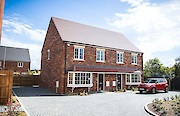


Mortgage Advisor & Director

Mortgage Advisor & Director

If part of a freehold property extends over (or under) a separate building, this is called a ‘flying freehold’. Although these can be unique and attractive buildings, the mortgage process can be more complex. Here we’ll cover whether you can get a mortgage, potential issues, and examples of flying freehold lenders.
Can you get a mortgage on a flying freehold property?
Yes, it’s definitely possible, but it can be more challenging for this property type. You’ll likely find there’s a smaller pool of lenders available for a flying freehold mortgage due to the slightly complex boundaries and legal ownership.
Examples of flying freehold properties
These are the sorts of buildings that may fall into the flying freehold category:
-
Maisonettes and duplexes with shared structures like walls or floors.
-
Overhanging rooms (perhaps above a garage or walkway).
-
Balconies that extend onto another property.
-
Basements under neighbouring properties.
-
Semi-detached or terraced houses where the dividing line isn’t straight.
Common problems with flying freehold mortgages
Here are some of the key issues with flying freeholds that can make it harder to get a mortgage:
-
Legal issues: One of the biggest potential problems is the legal ambiguity because there can be overlapping ownership. Lenders will want documentation and clarity showing exact responsibilities and access rights.
-
Maintenance agreements: Sometimes, maintenance agreements between all the property owners must be put in place for flying freeholds. These need to be extremely clear and well-documented, otherwise it could be an issue that leads lenders to decline a mortgage application.
-
Valuations: Depending on the structure, legal documents, and boundaries, a surveyor could highlight complications which may put some lenders off. It might mean that they won’t let you borrow as much or offer higher rates to offset the perceived risk.
-
Property insurance: You’ll need an insurance policy that covers your property and any flying freehold sections. With fewer potential insurers available, it may be challenging to get these policies, but lenders will still want proof of coverage.
Mortgage lending criteria
Here are some of the key factors that will be looked at when it comes to eligibility criteria for mortgages on a flying freehold property:
-
Flying freehold size: Each lender may impose restrictions around the extent of the flying freehold portion. For example, most lenders require it to be less than 25% of the total property.
-
Legal agreements: Lenders will want to ensure all the proper legal documentation is in place to avoid surprises. This usually means all ownership responsibilities for every part of the property are clearly defined and documented.
-
Expert comments: Some lenders will base their decision on comments from a surveyor or conveyancer. Lenders will lean on their specialist knowledge and opinion before making a decision.
-
Insurance: You’ll likely need to secure an insurance policy that covers the whole property, including the flying freehold section. This can be harder to get, but you may need to approach a specialist insurer.
-
Deposit: Some lenders may have loan-to-value (LTV) caps for flying freehold mortgages. And with some, using a larger deposit can make it easier to get a mortgage because this offsets some risk. However, a broker can potentially help you get a flying freehold mortgage whatever your deposit size.
Credit history: Because flying freeholds can involve more risk for lenders, they’ll want to carry out a thorough check of your credit history. If you happen to have bad credit, don’t fret; getting a mortgage can still be possible if you deal with the right lenders.
How to get a mortgage for a flying freehold
Here are some straightforward steps to follow if you want to get a flying freehold mortgage:
1. Gather your details: Along with your documents (proof of address, ID, and 3 months’ payslips and bank statements), you should get as much information as possible relating to the flying freehold property. Ideally, this includes a specialist survey with any supporting legal documents.
2. Get expert advice: Getting a flying freehold mortgage is difficult without expert guidance. Specialist support is extremely worthwhile because your broker can look at the flying freehold to pre-empt any potential issues. They can even introduce you to a solicitor, preventing any unnecessary rejections.
3. Apply for a mortgage: Once your broker has reviewed your details (including a check of your credit reports) and assessed the flying freehold property, they’ll introduce you to the right lender for your property. Your broker will also help walk you through the mortgage application process.
If you want to speak to one of our experienced brokers who specialises in flying freehold mortgages, you can get started below with a free, no obligation chat:

Get bespoke advice about flying freehold mortgages
Flying freehold mortgage lenders
Here are some examples of mainstream lenders and high-street banks that will consider flying freehold mortgages:
-
Nationwide: Although Nationwide will consider a flying freehold, it depends on the valuer’s confirmation that the property is suitable. Also, if it’s a duplex, the conveyancer must confirm the property is in an area covered by the West Yorkshire Act 1980.
-
NatWest: There is a maximum LTV of 90% for a flying freehold mortgage with NatWest (or 75% for buy-to-let mortgages). Also, it must be possible to enforce positive covenants against other occupants, confirmed with a written agreement to ensure maintenance, repair, and insurance are shared.
-
Halifax: You can get a flying freehold mortgage with Halifax, but it depends on surveyor guidance and meeting the rest of its eligibility criteria, which can be fairly strict.
If you want to see the full range of lenders who can provide the most flexibility for your flying freehold mortgage, while still offering the best rates, it’s well worth getting one of our advisers to introduce you to a suitable specialist lender.
Why choose Teito for your flying freehold mortgage?
Our brokers specialise in securing mortgages for challenging properties, including flying freeholds. To get a mortgage, you’ll often need to approach niche lenders who can be more flexible.
Because our brokers have plenty of experience with unique properties, they can help you overcome any problems or issues, arrange necessary surveys, and introduce you to the best flying freehold lender for your circumstances.
Here are some more of the reasons people choose us when getting a flying freehold mortgage:
-
Our brokers specialise in all types of flying freehold properties
-
We can introduce you to specialist lenders with excellent rates
-
Your first chat is free, with no obligation to proceed
-
We are 5-star rated on leading review sites
Ready to take advantage of a free, no-obligation chat with a broker who specialises in flying freehold mortgages? Get started here.
FAQs
They can sometimes be higher than for standard freehold properties because the ownership is more complex, and some lenders will view this as an added risk.
However, it will depend on the portion of the property that’s classed as a flying freehold, whether there are any legal agreements in place, the shared responsibilities, the lender you approach, and the overall strength of your application.
Choosing an Adviser
Selecting a qualified and experienced mortgage adviser is of great importance. To choose a suitable adviser, evaluate their qualifications, experience, and reputation, and ensure they are regulated by the Financial Conduct Authority (FCA).
Read reviews from previous clients and make sure they provide a clear explanation of the products and services they offer, as well as the fees and charges associated with them.


























































































































































